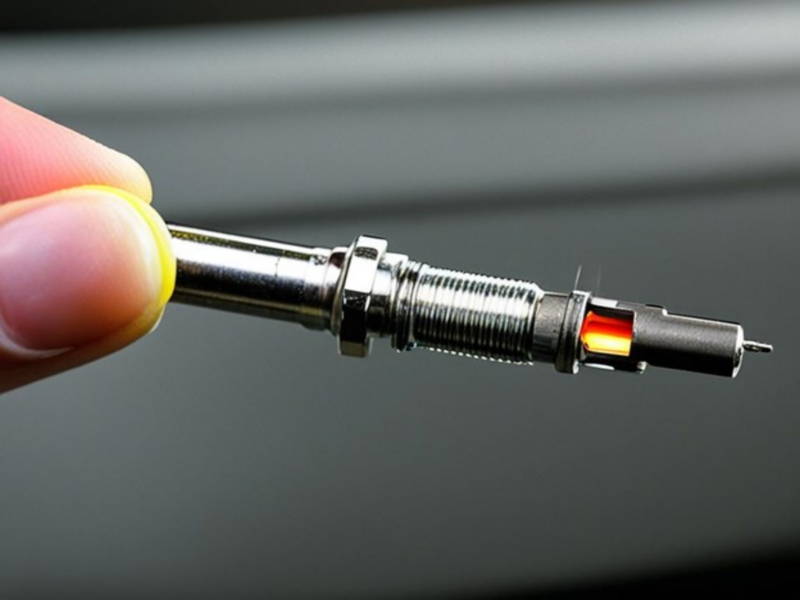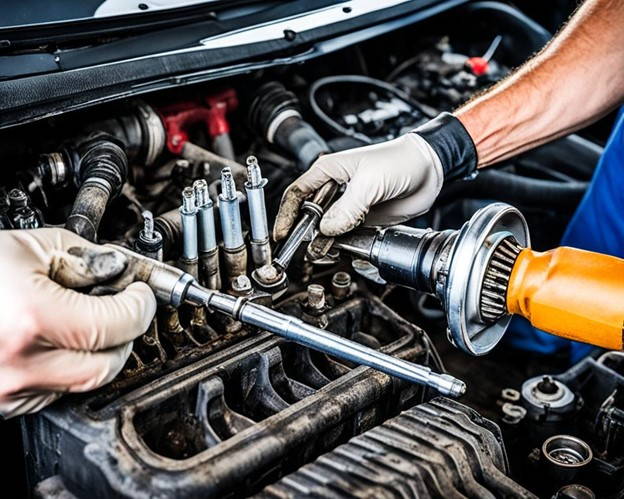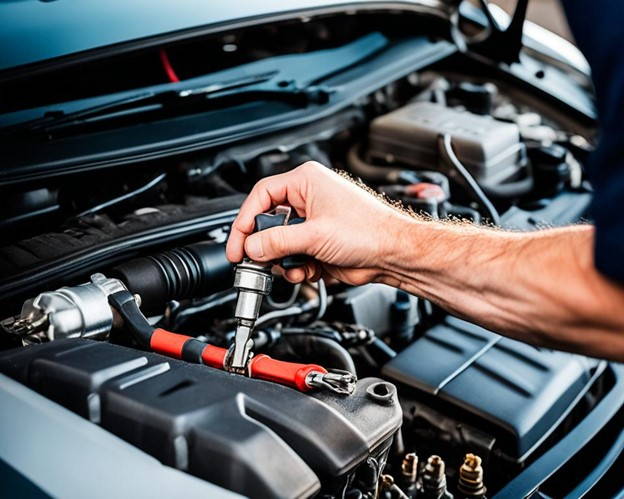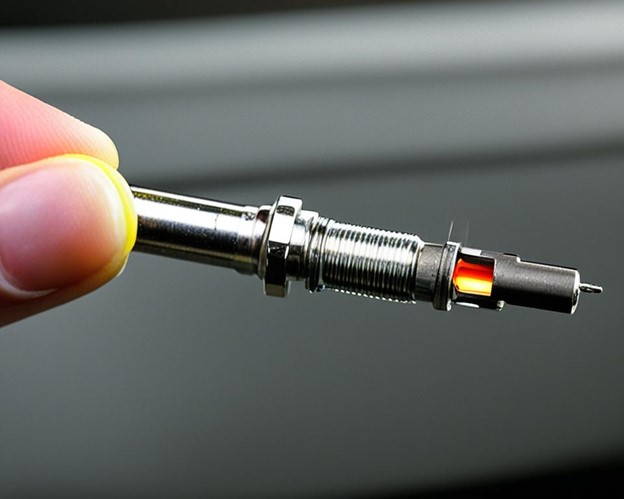
Keeping your car's engine in top shape is key for great performance and saving on gas. Spark plugs are a crucial part that needs regular check-ups. They make sure the air-fuel mix in the engine ignites right, which is key for smooth running and power.
In this guide, we'll show you how to replace spark plugs yourself. You'll get expert advice and tips to make your engine tune-up a success.

Key Takeaways
- Spark plugs are essential for engine performance and fuel efficiency
- Proper spark plug replacement can improve your car's overall driving experience
- Following a step-by-step guide can help you successfully replace spark plugs at home
- Utilizing the right tools and following safety precautions is crucial for a successful DIY project
- Maintaining your spark plugs regularly can prolong the lifespan of your engine
Identifying the Need for Spark Plug Replacement
Knowing when to replace spark plugs is key to keeping your car running well. If you ignore these signs, your engine might face problems like lower fuel efficiency, trouble starting, and poor performance.
Signs of Worn-Out Spark Plugs
One clear sign of bad spark plugs is a rough engine idle. If your engine starts to run unevenly, it might be time for a change. Also, if you notice your car uses more fuel or has less power, or if it's harder to start, your spark plugs could be worn out.
Another clue is increased engine vibration or misfiring. If your car shakes or jerks while moving, check your spark plugs for replacement.
Importance of Regular Maintenance
Replacing spark plugs regularly is key to keeping your engine running well and lasting longer. Most cars need new spark plugs every 30,000 to 100,000 miles, based on the type of vehicle. Not doing this can cause engine performance issues, like less fuel efficiency and difficulty starting the engine.
Spark Plug Replacement Interval
Typical Range
Recommended Replacement Interval
30,000 to 100,000 miles
Keeping up with spark plug maintenance helps your car run smoothly. This means better performance, more fuel efficiency, and fewer engine performance issues.

"Proper preparation is the key to a successful spark plug replacement. Take the time to gather the right tools and follow safety guidelines to ensure a smooth and efficient process."
"How to replace spark plugs" – Step-by-Step Instructions
Replacing spark plugs is a simple way to boost your car's performance and save on fuel. We'll walk you through the steps to replace your spark plugs. This includes getting the right tools and finding the spark plugs.
Gathering the Necessary Tools
Before starting, make sure you have the right tools. You'll need:
- Spark plug socket or wrench
- Torque wrench
- Wire brush or emery cloth (for cleaning the spark plug wells)
- Dielectric grease (to prevent corrosion)
- Replacement spark plugs (check the type and size for your car)
Having these tools ready will make replacing spark plugs easier and faster.
Locating and Accessing the Spark Plugs
Spark plugs are usually found on top of the engine or along the sides. They vary by car model and engine type. To get to them, you might need to remove covers or other parts.
After finding the spark plugs, use your socket or wrench to take out the old ones. Be careful not to touch the wiring connections.

With the old plugs out, you're set to put in the new ones. Make sure to follow the torque specs from the manufacturer for a tight fit.
Tips for Successful Spark Plug Installation
Replacing spark plugs is key for your vehicle's upkeep. But, doing it right is crucial for the best performance. Here are some tips to make sure your spark plug installation goes smoothly:
Torque Specifications and Gapping
Following the right torque specifications and spark plug gapping is vital. It keeps your engine running well for longer. Check your car's manual or the manufacturer's guide for the correct settings for your model.
- Torque Specifications: Tightening the spark plugs right ensures they stay secure and work well. This prevents leaks or misfires. Use a torque wrench to apply the exact force needed.
- Spark Plug Gapping: The gap between the electrodes is key for ignition. Use a feeler gauge to measure it and adjust as needed. This ensures the spark is right for efficient combustion.
Following the right spark plug installation tips, torque, and gapping makes a big difference. It helps your engine run better, saves fuel, and extends its life. By doing this, you keep your vehicle's ignition system in top shape.
"Proper spark plug installation and maintenance is a crucial step in keeping your vehicle running at its best. Neglecting these details can lead to costly repairs down the road."

Always check your vehicle's specific instructions for replacing spark plugs. This ensures a successful installation and keeps your engine running smoothly.
Troubleshooting Common Issues
Replacing spark plugs is usually easy, but sometimes you might run into problems. Let's look at a few common issues and how to fix them. This will help make sure the spark plug replacement goes smoothly.
Difficulty Removing Spark Plugs
Having trouble taking out the old spark plugs? It might be because they're corroded or stuck. Try using a spark plug socket with a long breaker bar or torque wrench for more power. Also, a penetrating lubricant on the threads can help break the seal.
Damaged Spark Plug Threads
If the threads in the cylinder head are damaged, putting in new spark plugs can be hard. You might need a professional to fix or replace the cylinder head. This ensures the new spark plugs fit securely.
Misfiring or Poor Engine Performance
Is your engine misfiring or running poorly after replacing spark plugs? It could be from wrong gap settings or bad spark plugs. Check the gap measurements and make sure the new spark plugs fit your vehicle. If problems keep happening, there might be a bigger issue with the ignition system or other parts that need checking.
By solving these common issues during spark plug replacement, you can prevent frustration and keep your engine running well. If you're unsure or run into problems, always get help from a professional mechanic.
Conclusion
In this guide, we've covered how to replace spark plugs in your vehicle. We talked about the signs of worn-out spark plugs and why regular maintenance is key. This ensures your engine runs well, uses less fuel, and lasts longer.
If you're new to DIY car work or just want to try replacing spark plugs, this guide is for you. It gives clear steps and expert tips to make the job easier. You'll learn how to get the right tools, properly torque, and gap the new spark plugs.
Keeping your spark plugs in good shape is important for your car. Follow the maker's advice on when to replace them and fix any problems fast. This leads to a better engine, better fuel use, and fewer emissions. With a well-kept ignition system, your car will run smoothly and make driving more fun for years.
FAQ
What are the signs that my spark plugs need to be replaced?
Signs that your spark plugs need replacing include rough idling and decreased fuel efficiency. You might also notice it's harder to start the engine, and overall engine performance suffers.
How often should I replace my spark plugs?
The timing for replacing spark plugs varies by your vehicle's make, model, and age. It also depends on the spark plug type. Always check your owner's manual or talk to a pro for the best schedule.
What tools do I need to replace the spark plugs?
You'll need a spark plug socket, a torque wrench, a gapping tool, and a ratchet or socket set for spark plug replacement. Having these tools ready makes the job easier and more successful.
How do I properly gap the new spark plugs?
Gapping your spark plugs right is key for the best engine performance. Use a gapping tool to set the gap as per the manufacturer's specs, usually between 0.028 and 0.035 inches.
What should I do if I encounter issues during the spark plug replacement process?
If you run into problems, like trouble removing old plugs or installing new ones, look at your vehicle's service manual. Or, get help from a professional mechanic. They can guide you through troubleshooting to fix the issue and complete the spark plug replacement successfully.

